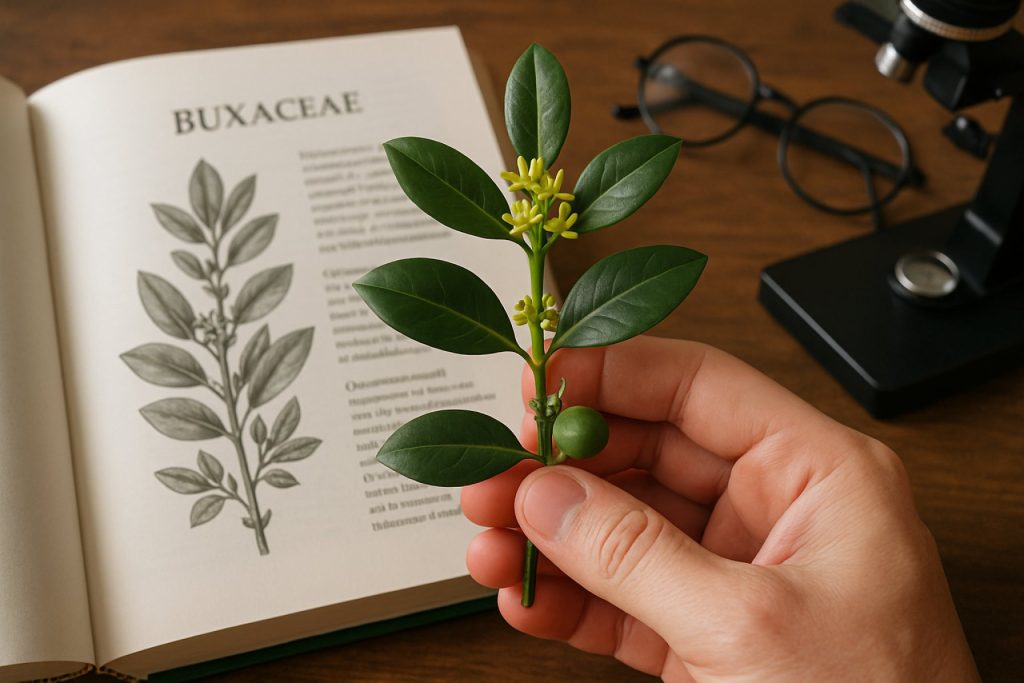
Buxaceae Botanical Classification Demystified: A Comprehensive Exploration of Boxwood Family Diversity, Evolution, and Taxonomy
- Introduction to the Buxaceae Family
- Historical Perspectives on Buxaceae Classification
- Morphological Characteristics Defining Buxaceae
- Molecular Phylogenetics and Genetic Insights
- Key Genera and Species within Buxaceae
- Geographical Distribution and Habitat Diversity
- Evolutionary Relationships and Divergence
- Taxonomic Challenges and Recent Revisions
- Economic and Ecological Significance of Buxaceae
- Future Directions in Buxaceae Research
- Sources & References
Introduction to the Buxaceae Family
The Buxaceae family, commonly known as the boxwood family, is a small but significant group of flowering plants within the order Buxales. This family is primarily composed of evergreen shrubs and small trees, many of which are widely recognized for their ornamental value and use in horticulture. The botanical classification of Buxaceae is based on a combination of morphological characteristics and, more recently, molecular phylogenetic studies that have clarified its relationships within the angiosperms.
Buxaceae is classified under the kingdom Plantae, division Magnoliophyta (angiosperms), class Magnoliopsida (dicotyledons), and order Buxales. The family is relatively small, comprising approximately five genera: Buxus, Pachysandra, Sarcococca, Notobuxus, and Styloceras. Of these, Buxus is the most widely known and cultivated, containing the classic boxwoods used in gardens and landscaping worldwide. The family is distributed across temperate and subtropical regions, with species native to Europe, Asia, Africa, and the Americas.
Morphologically, members of the Buxaceae family are characterized by their simple, opposite, or alternate leaves, which are often leathery and evergreen. The flowers are typically small, unisexual, and lack petals, arranged in clusters or solitary. The fruit is usually a capsule or drupe, containing one or more seeds. These features, along with unique anatomical traits such as the presence of alkaloids and specific wood structures, help distinguish Buxaceae from other plant families.
Recent advances in molecular systematics have provided further insight into the classification and evolutionary relationships of Buxaceae. DNA sequencing and phylogenetic analyses have confirmed the monophyly of the family and clarified its placement within the order Buxales, which is considered a basal lineage among the eudicots. These studies have also led to the re-evaluation of certain genera and species boundaries within the family, ensuring a more accurate and natural classification system.
The botanical classification of Buxaceae is recognized and maintained by leading botanical authorities such as the Royal Botanic Gardens, Kew and the American Public Gardens Association. These organizations play a crucial role in the ongoing research, documentation, and conservation of Buxaceae species, supporting both scientific understanding and horticultural practice.
Historical Perspectives on Buxaceae Classification
The botanical classification of the Buxaceae family, commonly known as the boxwood family, has a rich and evolving history that reflects broader trends in plant taxonomy. Traditionally, Buxaceae has been recognized as a distinct family within the order Buxales, characterized by evergreen shrubs and small trees with simple, opposite leaves and inconspicuous flowers. The family’s most well-known genus, Buxus, includes species widely used in horticulture and landscaping.
Early botanical works, such as those by Carl Linnaeus in the 18th century, placed Buxus and related genera within a loosely defined group of dicotyledonous plants. As botanical science advanced, particularly in the 19th and early 20th centuries, taxonomists began to refine the circumscription of Buxaceae based on morphological features such as leaf arrangement, flower structure, and fruit type. The family was generally considered small, with only a handful of genera, including Buxus, Pachysandra, and Sarcococca.
The advent of molecular phylogenetics in the late 20th and early 21st centuries brought significant changes to the understanding of Buxaceae relationships. DNA sequencing studies revealed that some genera previously included in Buxaceae, or closely allied families, were more distantly related than morphological traits had suggested. Conversely, certain genera, such as Didymeles and Haptanthus, were at times considered for inclusion in Buxaceae based on genetic evidence, though their placement remains debated among taxonomists.
The Royal Botanic Gardens, Kew, a leading authority in plant taxonomy, recognizes Buxaceae as comprising several genera, with ongoing research into their precise relationships. The Missouri Botanical Garden and the American Botanical Council also contribute to the taxonomic understanding of the family, maintaining updated checklists and databases that reflect the latest scientific consensus.
Historically, the classification of Buxaceae has illustrated the challenges of plant taxonomy, where morphological convergence and limited distinguishing features can obscure evolutionary relationships. The integration of molecular data has clarified many aspects of Buxaceae classification, but debates continue regarding the boundaries of the family and the status of certain genera. This ongoing refinement underscores the dynamic nature of botanical classification and the importance of both traditional and modern approaches in understanding plant diversity.
Morphological Characteristics Defining Buxaceae
The Buxaceae family, commonly known as the boxwood family, is a small but distinct group of flowering plants within the order Buxales. This family is primarily characterized by a suite of morphological features that set it apart from other angiosperms. Members of Buxaceae are typically evergreen shrubs or small trees, though some species may present as subshrubs or, rarely, as herbaceous plants. The most widely recognized genus within the family is Buxus, which includes the well-known boxwoods used extensively in horticulture.
A defining characteristic of Buxaceae is their simple, opposite, or occasionally alternate leaves. These leaves are usually leathery, entire (smooth-edged), and lack stipules—a feature that helps distinguish them from related families. The leaf arrangement and texture contribute to the plants’ resilience and adaptability, particularly in ornamental settings.
The reproductive structures of Buxaceae are also distinctive. Flowers are typically small, inconspicuous, and unisexual, with male and female flowers often found on the same plant (monoecious), though some species are dioecious. The flowers lack petals, consisting instead of a perianth made up of sepals. Male flowers generally have four stamens, while female flowers possess a superior ovary with two or three carpels, each containing a single ovule. This floral simplicity is a key diagnostic trait for the family.
Fruit morphology further aids in the identification of Buxaceae. The fruit is usually a capsule that splits open at maturity to release seeds, which are often black and may be covered with a fleshy aril. This mode of seed dispersal is relatively uncommon among related plant families and provides an additional taxonomic marker.
Anatomically, Buxaceae species exhibit unique wood and leaf structures. The wood is typically dense and fine-grained, a property that has made boxwood valuable for carving and fine woodworking. The leaves contain specialized cells known as idioblasts, which may store calcium oxalate crystals, contributing to the plant’s defense mechanisms.
These morphological characteristics—evergreen habit, simple leathery leaves, unisexual apetalous flowers, capsular fruit, and specialized anatomical features—collectively define the Buxaceae family and support its classification within the order Buxales. The family’s botanical distinctiveness is recognized by major botanical authorities such as the Royal Botanic Gardens, Kew and the Missouri Botanical Garden, both of which maintain comprehensive taxonomic databases and research programs on plant families worldwide.
Molecular Phylogenetics and Genetic Insights
Molecular phylogenetics has revolutionized the botanical classification of the Buxaceae family, providing a robust framework for understanding evolutionary relationships that were previously obscured by morphological convergence and plasticity. The Buxaceae, commonly known as the boxwood family, comprises several genera, including Buxus, Pachysandra, Sarcococca, and the monotypic Didymeles. Traditional taxonomy, based largely on vegetative and reproductive morphology, often struggled to resolve the relationships within this family due to the subtle and overlapping characteristics among its members.
With the advent of molecular techniques, particularly the sequencing of chloroplast DNA regions such as rbcL, matK, and nuclear ribosomal ITS, researchers have been able to clarify the phylogenetic structure of Buxaceae. These genetic markers have revealed that the family is monophyletic, supporting its recognition as a distinct lineage within the order Buxales. Molecular data have also confirmed the separation of Didymeles as a basal lineage, distinct from the core Buxaceae, which includes Buxus, Pachysandra, and Sarcococca. This finding has led some taxonomists to propose the segregation of Didymeles into its own family, Didymelaceae, though consensus remains with its inclusion in Buxaceae for most current classifications.
Genetic insights have further refined the internal classification of the family. For example, molecular phylogenies have demonstrated that Buxus is not only the largest genus but also exhibits significant genetic divergence between its Eurasian, African, and American clades. This has prompted the recognition of subgenera or sections within Buxus based on both molecular and morphological evidence. Similarly, the close relationship between Pachysandra and Sarcococca has been corroborated by DNA sequence data, supporting their placement in a subfamily distinct from Buxus.
The integration of molecular data has also facilitated the identification of cryptic species and clarified the evolutionary history of the family, including patterns of biogeography and diversification. These advances are reflected in the most recent taxonomic treatments and are recognized by leading botanical authorities such as the Royal Botanic Gardens, Kew and the Missouri Botanical Garden, both of which maintain comprehensive and up-to-date databases on plant taxonomy. As molecular techniques continue to evolve, they are expected to yield even deeper insights into the genetic diversity and evolutionary dynamics of Buxaceae.
Key Genera and Species within Buxaceae
The Buxaceae family, commonly known as the boxwood family, is a small but significant group within the order Buxales. This family is primarily composed of evergreen shrubs and small trees, many of which are valued for their ornamental and horticultural uses. The Buxaceae family is distributed widely, with species native to Europe, Asia, Africa, and the Americas. Its members are characterized by simple, opposite leaves, small unisexual flowers, and capsule or drupe-like fruits.
Within Buxaceae, the most prominent and widely recognized genus is Buxus. This genus includes approximately 70–100 species, depending on the taxonomic authority. Buxus sempervirens, commonly known as common boxwood, is native to western and southern Europe, northwest Africa, and southwest Asia. It is extensively cultivated for hedges, topiary, and landscape design due to its dense, evergreen foliage and tolerance of pruning. Other notable species include Buxus microphylla (Japanese boxwood) and Buxus balearica (Balearic boxwood), each adapted to specific regional climates and soils.
Another key genus within the family is Sarcococca, often referred to as sweet box. This genus comprises about 11 species, native primarily to eastern and southeastern Asia. Sarcococca confusa and Sarcococca hookeriana are popular in ornamental horticulture, prized for their glossy leaves and fragrant winter flowers. Unlike Buxus, Sarcococca species are generally shade-tolerant and thrive in understory environments.
The genus Pachysandra is another important member of Buxaceae, with species such as Pachysandra terminalis (Japanese spurge) widely used as ground cover in temperate gardens. Pachysandra species are herbaceous or subshrubby, differing from the woody habit of most Buxus species. They are valued for their ability to form dense mats in shaded areas, suppressing weeds and stabilizing soil.
A less commonly encountered genus is Styloceras, native to the Andean regions of South America. This genus includes small trees and shrubs, and while not widely cultivated, it is of botanical interest due to its unique morphological features within the family.
The classification and circumscription of Buxaceae have been refined through molecular phylogenetic studies, which have clarified relationships among its genera and species. The family is recognized and described by major botanical authorities such as the Royal Botanic Gardens, Kew and the Missouri Botanical Garden, both of which maintain comprehensive databases and resources on Buxaceae taxonomy.
Geographical Distribution and Habitat Diversity
The Buxaceae family, commonly known as the boxwood family, exhibits a broad geographical distribution and remarkable habitat diversity, reflecting its evolutionary adaptability. This family comprises approximately five genera, including Buxus (boxwood), Pachysandra, Sarcococca, Notobuxus, and Styloceras. The most widely recognized genus, Buxus, is native to regions spanning Europe, Asia, Africa, and the Americas, with the highest species diversity found in tropical and subtropical zones.
Buxaceae species are distributed across a variety of ecological zones. In Europe and the Mediterranean, Buxus sempervirens is a familiar component of woodlands and calcareous soils, often forming dense understory thickets. In East Asia, species such as Buxus microphylla and Sarcococca thrive in forested mountain slopes and shaded valleys, demonstrating a preference for moist, well-drained soils. North American representatives, like Pachysandra terminalis, are commonly found in deciduous forests, where they serve as ground cover in shaded environments.
The family’s adaptability is further evidenced by its presence in both temperate and tropical climates. For instance, Buxus balearica is endemic to the Mediterranean islands, tolerating dry, rocky habitats, while Styloceras species are native to the Andean regions of South America, where they occupy montane cloud forests. This ecological plasticity allows Buxaceae members to colonize diverse habitats, from limestone outcrops and scrublands to humid forests and cultivated gardens.
The global distribution of Buxaceae is shaped by both natural dispersal and human cultivation. Boxwoods have been widely introduced as ornamental plants in temperate regions worldwide, contributing to their presence outside native ranges. However, wild populations remain concentrated in specific biogeographical zones, often reflecting ancient continental connections and climatic shifts.
Conservation concerns have arisen for some Buxaceae species due to habitat loss, overharvesting, and disease pressures, particularly in their native habitats. Organizations such as Botanic Gardens Conservation International and various national botanical institutions monitor the status of wild populations and promote ex situ conservation efforts. Understanding the geographical and ecological breadth of Buxaceae is essential for informed conservation and sustainable management of this botanically and horticulturally significant family.
Evolutionary Relationships and Divergence
The Buxaceae family, commonly known as the boxwood family, occupies a distinct position within the order Buxales, a relatively small lineage among the eudicots. The family comprises approximately five genera, including Buxus (boxwood), Pachysandra, Sarcococca, Notobuxus, and Styloceras. The evolutionary relationships within Buxaceae and its divergence from related groups have been clarified through both morphological and molecular phylogenetic studies.
Molecular analyses, particularly those utilizing chloroplast DNA sequences, have consistently supported the monophyly of Buxaceae, distinguishing it from other families within the Buxales. The family is characterized by simple, evergreen leaves, unisexual flowers, and a unique capsule fruit type. These features, along with genetic data, have helped taxonomists delineate the family’s boundaries and clarify its evolutionary history. The Royal Botanic Gardens, Kew and the Missouri Botanical Garden are leading authorities in plant taxonomy and have contributed significantly to the current understanding of Buxaceae classification.
Within Buxaceae, the genus Buxus is the most speciose and widely distributed, with species native to Europe, Asia, Africa, and the Americas. Phylogenetic studies indicate that Buxus diverged early from other genera in the family, with subsequent radiations leading to the diversification of Pachysandra and Sarcococca, which are primarily found in East Asia and North America. The genera Notobuxus and Styloceras are more geographically restricted, occurring in Africa and South America, respectively, and represent ancient lineages within the family.
The divergence of Buxaceae from other eudicot families is estimated to have occurred during the early Cretaceous period, over 100 million years ago. This ancient origin is supported by fossil evidence and molecular clock analyses. The family’s evolutionary trajectory has been shaped by continental drift and climatic changes, leading to its current disjunct distribution. The Botanical Society of America and the Royal Botanic Gardens Victoria provide resources and research on plant evolutionary relationships, including those of Buxaceae.
In summary, the Buxaceae family represents an early-diverging lineage within the eudicots, with a well-supported monophyly and a complex evolutionary history marked by ancient divergence and subsequent geographic and morphological diversification.
Taxonomic Challenges and Recent Revisions
The botanical classification of the Buxaceae family, commonly known as the boxwood family, has long presented taxonomic challenges due to its morphological diversity and wide geographic distribution. Traditionally, Buxaceae was recognized as a small family within the order Buxales, comprising several genera such as Buxus, Pachysandra, and Sarcococca. However, the precise delimitation of genera and species within the family has been contentious, with ongoing debates regarding the inclusion or exclusion of certain taxa.
One of the primary challenges in Buxaceae taxonomy arises from the subtle morphological differences among its members. For example, the genera Buxus and Sarcococca share many vegetative and reproductive traits, making it difficult to distinguish them based solely on traditional morphological characters. Additionally, the presence of both herbaceous and woody forms within the family complicates the establishment of clear diagnostic features. This has led to frequent re-evaluations of generic boundaries and species circumscription.
Recent advances in molecular phylogenetics have significantly impacted the classification of Buxaceae. DNA sequencing studies have revealed previously unrecognized relationships among genera and species, prompting taxonomists to revise the family’s internal structure. For instance, molecular data have supported the monophyly of Buxaceae but have also indicated that some traditionally recognized genera, such as Pachysandra, may be paraphyletic or polyphyletic, necessitating further taxonomic revision. These findings have led to the proposal of new genera and the reclassification of certain species, reflecting a more accurate evolutionary history of the family.
The Royal Botanic Gardens, Kew, a leading authority in plant taxonomy, has played a pivotal role in updating the classification of Buxaceae through its comprehensive databases and collaborative research initiatives. The Missouri Botanical Garden also contributes to ongoing taxonomic work by maintaining extensive herbarium collections and supporting molecular studies. Both institutions emphasize the importance of integrating morphological, anatomical, and molecular data to resolve longstanding taxonomic ambiguities within the family.
Despite these advances, challenges remain, particularly in regions with high species diversity or limited herbarium representation. Continued fieldwork, combined with next-generation sequencing technologies, is expected to further refine the classification of Buxaceae and clarify the evolutionary relationships among its members. As taxonomic frameworks evolve, authoritative organizations such as Kew and the Missouri Botanical Garden will remain central to the dissemination of updated and accurate botanical information.
Economic and Ecological Significance of Buxaceae
The Buxaceae family, commonly known as the boxwood family, is a small but significant group within the order Buxales. This family is primarily composed of evergreen shrubs and small trees, with the genus Buxus being the most widely recognized and economically important. The Buxaceae family is distributed globally, with species native to Europe, Asia, Africa, the Americas, and Madagascar, reflecting a broad ecological adaptability.
Botanically, Buxaceae is characterized by simple, opposite or subopposite leaves, small unisexual flowers, and a distinctive capsule fruit. The family comprises approximately five genera: Buxus, Sarcococca, Pachysandra, Notobuxus, and Styloceras. Of these, Buxus is the largest and most widely cultivated, containing about 70–100 species. Sarcococca (sweet box) and Pachysandra are also notable for their use as ornamental groundcovers, especially in temperate gardens.
Taxonomically, the Buxaceae family has undergone several revisions as molecular phylogenetic studies have clarified relationships within the group. Historically, the family was placed in the order Euphorbiales, but recent genetic evidence supports its placement in the order Buxales, a position now widely accepted by leading botanical authorities such as the Royal Botanic Gardens, Kew and the Missouri Botanical Garden. The Royal Botanic Gardens, Kew maintains the World Checklist of Selected Plant Families, which recognizes the current circumscription of Buxaceae and its genera.
The family’s botanical classification is significant for both economic and ecological reasons. Economically, species such as Buxus sempervirens are highly valued in horticulture for their dense, evergreen foliage and tolerance of heavy pruning, making them ideal for topiary and formal hedging. Ecologically, Buxaceae species play important roles in their native habitats, providing shelter and food for various insects and animals. Some species, such as those in the genus Sarcococca, are also noted for their fragrant flowers, which attract pollinators during winter months when few other plants are in bloom.
In summary, the botanical classification of Buxaceae underpins its horticultural value and ecological function, with ongoing research by institutions like the Royal Botanic Gardens, Kew and the Missouri Botanical Garden continuing to refine our understanding of this important plant family.
Future Directions in Buxaceae Research
The botanical classification of the Buxaceae family, which includes well-known genera such as Buxus (boxwood), Pachysandra, and Sarcococca, has long been a subject of both traditional taxonomy and modern phylogenetic research. As molecular techniques advance, future directions in Buxaceae research are increasingly focused on refining the family’s classification, resolving phylogenetic ambiguities, and understanding evolutionary relationships within the group.
One of the primary areas for future research is the integration of molecular data with classical morphological characteristics. Historically, Buxaceae classification relied heavily on observable traits such as leaf arrangement, flower structure, and fruit type. However, recent advances in DNA sequencing have revealed cryptic diversity and unexpected relationships among species, prompting taxonomists to reconsider traditional groupings. For example, molecular phylogenetic studies have suggested that some genera within Buxaceae may be paraphyletic or polyphyletic, indicating the need for taxonomic revision and possibly the recognition of new genera or subfamilies.
Another promising direction is the use of next-generation sequencing (NGS) technologies to generate comprehensive genomic datasets. These datasets can help clarify deep evolutionary splits within the family and provide insights into biogeographic patterns, such as the disjunct distribution of Buxaceae species across Eurasia, Africa, and the Americas. Such research is crucial for understanding the historical processes that have shaped the current diversity and distribution of the family.
Additionally, there is growing interest in the application of integrative taxonomy, which combines molecular, morphological, ecological, and chemical data to produce a more robust and holistic classification. This approach is particularly valuable for resolving species complexes and identifying cryptic species, which are common in Buxaceae due to their often subtle morphological differences.
International organizations such as the Royal Botanic Gardens, Kew and the Botanic Gardens Conservation International play a pivotal role in supporting Buxaceae research by maintaining living collections, herbarium specimens, and genetic resources. Their collaborative efforts facilitate global taxonomic revisions and the dissemination of up-to-date classification frameworks.
In summary, the future of Buxaceae botanical classification lies in the continued integration of molecular and morphological data, the adoption of cutting-edge genomic tools, and international collaboration. These efforts will not only refine the taxonomy of this important plant family but also enhance our understanding of its evolutionary history and conservation needs.
Sources & References
- Royal Botanic Gardens, Kew
- American Public Gardens Association
- Missouri Botanical Garden
- Missouri Botanical Garden
- Botanic Gardens Conservation International
- Botanical Society of America
- Royal Botanic Gardens Victoria



